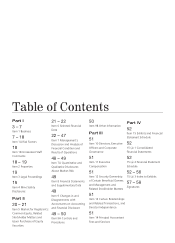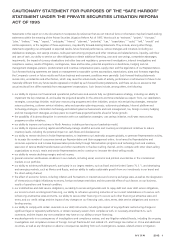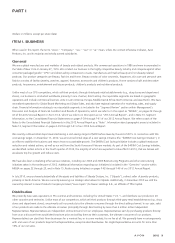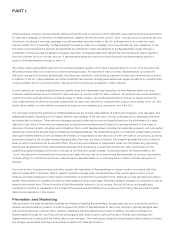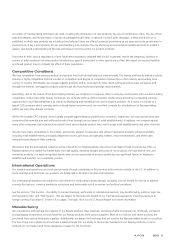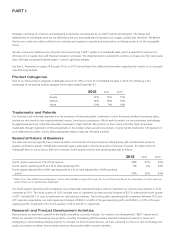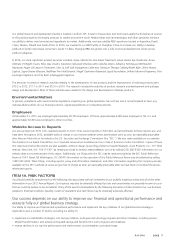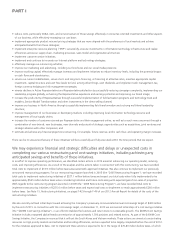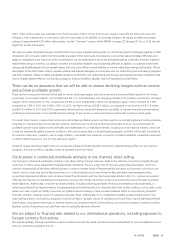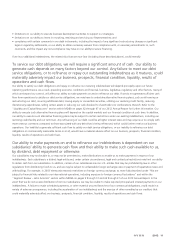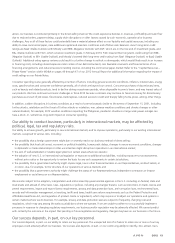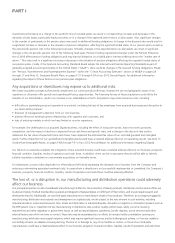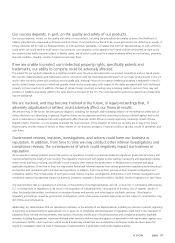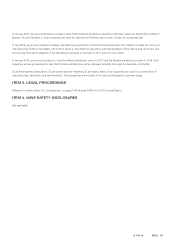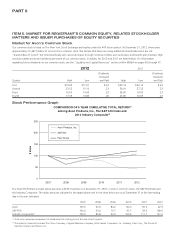Avon 2012 Annual Report Download - page 17
Download and view the complete annual report
Please find page 17 of the 2012 Avon annual report below. You can navigate through the pages in the report by either clicking on the pages listed below, or by using the keyword search tool below to find specific information within the annual report.PART I
One risk associated with our international operations is that the functional currency for most of our international operations is the applicable
local currency. For example, currencies for which we have significant exposures include the Argentine peso, Australian dollar, Brazilian real,
British pound, Canadian dollar, Chinese renminbi, Colombian peso, the Czech Republic koruna, the euro, Mexican peso, New Zealand
dollar, Peruvian new sol, Philippine peso, Polish zloty, Russian ruble, South Africa rand, Turkish lira, and Ukrainian hryvnia. As a result,
movements in exchange rates may have a significant impact on our business, assets, financial condition, liquidity, results of operations and
cash flows. For example, in 2012, our revenues declined 5% compared to 2011 due to unfavorable foreign exchange, but were relatively
unchanged on a Constant $ basis. There can be no assurance that foreign currency fluctuations will not have a material adverse effect on
our business, assets, financial condition, liquidity, results of operations or cash flows.
Another risk associated with our international operations is the possibility that a foreign government may impose currency remittance
restrictions. Due to the possibility of government restrictions on transfers of cash out of the country and control of exchange rates, we may
not be able to immediately repatriate cash at the official exchange rate. If this should occur, or if the official exchange rate devalues, it may
have a material adverse effect on our business, assets, financial condition, liquidity, results of operations or cash flows. For example, currency
restrictions enacted by the Venezuelan government in 2003 have become more restrictive and have impacted the ability of our subsidiary in
Venezuela (Avon Venezuela) to obtain foreign currency at the official rate to pay for imported products. We are currently unable to predict
the likelihood of government approvals of these requests, or if approved, the estimated time for remittance. Unless official foreign exchange
is made more readily available, Avon Venezuela’s operations will continue to be negatively impacted as it will need to obtain more of its
foreign currency needs from non-government sources where the exchange rate is less favorable than the official rate.
Inflation is another risk associated with our international operations. For example, Venezuela has been designated as a highly inflationary
economy, and in February 2013 the Venezuelan government devalued its currency for the second time since January 1, 2010. Gains and
losses resulting from the remeasurement of the financial statements of subsidiaries operating in highly inflationary economies are recorded
in earnings. Given Venezuela’s designation as a highly inflationary economy, the devaluation of the official rate and the potential for future
devaluation, our revenue, operating profit, and net income will continue to be negatively impacted in 2013 and beyond. See the “Segment
Review – Latin America” section within MD&A on pages 34 through 37 of our 2012 Annual Report for additional information regarding
Venezuela. In addition, there can be no assurance that other countries in which we operate, such as Argentina, will not also become highly
inflationary and that our revenue, operating profit, and net (loss) income will not be adversely impacted as a result.
Our indebtedness and debt service obligations could materially adversely affect our business,
prospects, financial condition, liquidity, results of operations and cash flows.
As of December 31, 2012, we had approximately $3.2 billion of indebtedness outstanding and approximately $250 million of the $1 billion
revolving credit facility could have been drawn down without violating any covenant. As of December 31, 2012, we had $375 million and
$500 million of outstanding indebtedness that matures and will need to be refinanced or repaid in 2013 and March 2014, respectively. In
addition, $137.5 million of the Company’s term loan is due in June 2014. We may also incur additional long-term indebtedness and working
capital lines of credit to meet future financing needs, subject to certain restrictions under our indebtedness, including our revolving credit
facility and our term loan, which would increase our total indebtedness. We may be unable to generate sufficient cash flow from operations
and future borrowings and other financing may be unavailable in an amount sufficient to enable us to fund our future financial obligations
or our other liquidity needs. Our indebtedness could have material negative consequences on our business, prospects, financial condition,
liquidity, results of operations and cash flows, including the following:
• limitations on our ability to obtain additional debt or equity financing sufficient to fund growth, such as working capital and capital
expenditures requirements or to meet debt service requirements or other cash requirements, in particular during periods in which credit
markets are weak;
• a downgrade in our credit ratings;
• an allocation of a substantial portion of our cash flow from operations to service our debt, thus reducing the amount of our cash flow
available for other purposes, including operating costs and capital expenditures that could improve our competitive position and operating
results;
• a sale of debt or equity securities or sale of some of our core assets (subject to certain restrictions under our existing indebtedness,
including our revolving credit facility and our term loan), possibly on unfavorable terms, to meet payment obligations;
• a limitation on our flexibility to plan for, or react to, competitive challenges in our business and the beauty industry;
• the possibility that we are put at a competitive disadvantage relative to competitors that do not have as much debt as us, and competitors
that may be in a more favorable position to access additional capital resources and withstand economic downturns;


